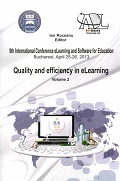TRADITIONAL Vs. E-LEARNING LANGUAGE ACQUISITION. TEACHER – STUDENT ROLES
TRADITIONAL Vs. E-LEARNING LANGUAGE ACQUISITION. TEACHER – STUDENT ROLES
Author(s): Luiza KRAFT, Diana Ţuţuianu, Ana-Maria Chisega-NegrilăSubject(s): Education
Published by: Carol I National Defence University Publishing House
Keywords: teachers' roles; E-learning; blended learning; VLSs
Summary/Abstract: The advancement in computing and teaching has led to the creation of VLEs (Virtual Learning Environments), which marked a turning point in education and in the way people gained access to knowledge as part of life-long learning. The low costs, the possibility to access the content anywhere and anytime, and the use of modern technology make VLEs very popular among learners. The use of technology on the one hand, and of social media and software, on the other, has generated a shift from the teacher-based learning to the technology-based one. In this context, information will be provided mediated by the platform and the teacher will withdraw physically, except for the case of blended learning, where teacher-student communication resembles to some extent the one used in the traditional courses. The traditional teachers’ roles were meant therefore to change in order to bridge the gap created by the interface. Some institutions relied on attractive software, embedding blogging and social media into their courses, others on virtual classrooms in Second Life with the use of avatars to mimic the traditional presence of the teacher with a hi-tech flavor. Thus, the teachers’ function in VLEs is more connected with the necessity to provide mentorship and weld the group of students, who are more autonomous than those enrolled in traditional courses, in order to ensure learning. By exploring resemblances, differences, common roots, weaknesses and strengths, in other words, by performing comparative analysis, the paper will look into the changes which have occurred in teachers’ and learners’ roles over time alongside with the momentum gained by e-learning courses.
Journal: Conference proceedings of »eLearning and Software for Education« (eLSE)
- Issue Year: 9/2013
- Issue No: 02
- Page Range: 580-586
- Page Count: 6
- Language: English

